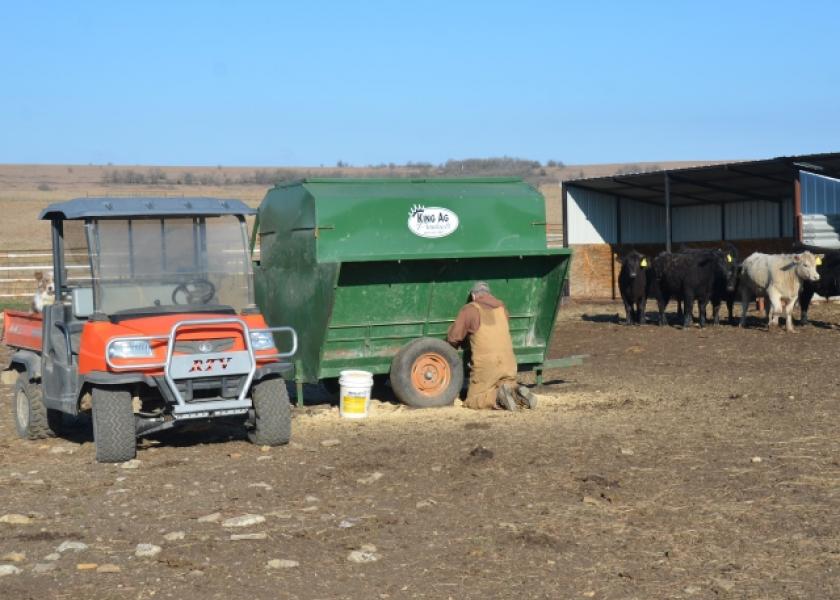BeefTalk: Labor, Facilities and Equipment are Big Beef Expenses

Cow-calf producers need to work smarter, not harder.
By: Kris Ringwall, Beef Specialist, NDSU Extension Service
Do you want to invest in labor, facilities and equipment to deliver the feed?
The answer to this question should determine the bull turnout date, which sets the date when the third trimester of pregnancy starts, which determines the calving date. The third trimester and subsequent calving marks the most nutritionally demanding period in the annual cycle of meeting the needs of the cow.
Another question: Should bull turnout set calving time to better match the environment?
Because labor, facilities and equipment are fiscally resource-heavy, the Dickinson Research Extension Center, in 2012, decided to take the jump and place cows on pasture to calve. This decision allows the cow to eat for herself the copious amounts of daily feed she requires at calving and during lactation, and opens December, January and early February as a time to save money by grazing crop aftermath, residual corn forage, cover crops and other residual forage.
This decision has the potential to lower winter feed costs significantly.
Historically, the center turned bulls out June 1 or thereabouts for March/April calving. The average date that the third mature cow calved was typically March 15 and the typical average calving date was March 29.
Since 2012, the center has delayed the turnout of the bulls to Aug. 1 or thereabouts. The average date that the third mature cow calved during those years was May 7 and the average calving date was May 25. This significantly changed labor, facility usage and equipment needs.
The date the third mature cow calves is a typical date used to say the calving season has begun officially. So, given this backdrop, the beef business is a relatively traditional business with extensive roots in the ground, which anchors the business to the land. Land is relatively stable and constant, and change within the business often is limited.
Within beef operations, new concepts can be generated fairly quickly. Once a fairly critical eye is applied to the newness, one finds most of the change is variable inputs to the operation. These new variable inputs are generally cost-effective, each in its own right, and the new items generally are applied within established, seasoned production systems.
In other words, the base operation is constant. Bulls are bought, cows are bred, calves are born, calves grow and calves are sold. The cycle is repetitious.
What’s the point? Looking down the road, the future is gray: lower prices and increased costs, without an incremental decrease in costs, along with an incremental increase in outputs. Despite stability, the dollar pressure remains.
What can a cow-calf producer do? Several things come to the table fairly quickly during the discussion; labor, facilities and equipment surface repeatedly.
Labor costs need to be lowered. In some cases, the owner, manager and general labor are separate people; in other situations, those positions are one person. So working smarter, not harder, is the key.
Facilities are expensive. Cow-calf operations need to be less dependent on facilities and equipment. Not only will initial investment take dollars, but subsequent depreciation of these facilities and equipment is real, and someone has to ante up the dollars. Unfortunately, investment in facilities and equipment often coincides with high prices, and subsequent depreciation costs often occur as prices lower. Beef production needs to be “lean and mean.”
Survival in the cow-calf business may mean shifting the traditional mode of operation and re-focusing on the elimination of high-input time periods, thus the thoughts regarding bull turnout and calving. Again, bull turnout should match the nutritional phases of a cow: early lactation, lactation and first trimester of pregnancy, second trimester of pregnancy and third trimester of pregnancy.
When the calves are weaned and the cows are nonlactating and still in the second trimester of pregnancy, cow management should be at its simplest. This is the time the cows can rough it, thus the discussion of calving time.
The three months before calving and the months immediately following calving are the most demanding nutritionally. Should not bull turnout be set to minimize the amount of labor and facilities by calving the cows when pasture is available rather than hauling the feed to the cows?
I do understand that this is not a simple question. Every operation is slightly different, and every location has different demands. But no one wants to lose money and certainly not place the cow-calf enterprise in fiscal jeopardy. Bull turnout when?
May you find all your ear tags.







